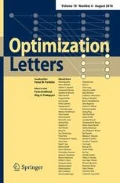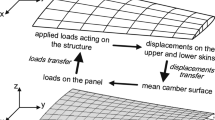Abstract
The work presented in this paper deals with the accuracy of the sensitivity derivatives of aerodynamic cost functions obtained by using an adjoint method. The accuracy of these gradients is evaluated by comparison with gradients computed via finite-differences in a straight-forward manner. The advantages of the use of an adjoint method become extremely clear since the computational effort incurred in the calculation of a complete gradient with respect to an arbitrary number of variables is independent of the number of variables and the only cost involved is the calculation of one flow solution and one adjoint solution, where the adjoint equation is a linear equation and, hence, of reduced complexity. In order to focus on the design and optimization procedure, we limit our study to one of the simplest flows: a subsonic potential flow over an airfoil section. First, for a generic objective function, we present a tool to automatically compute the gradient expression through adjoint techniques based on MAPLE, one of the most powerful computer algebra system (CAS). Second, exploiting the linearity of the governing equation, an adjoint solver is implemented based on the classical Douglas-Neumann panel method. The use of the solver is illustrated for a sample design calculation.





Similar content being viewed by others
References
Cheb-Terrab, E.S.: Maple procedures for partial and functional derivatives. Comp. Phys. Commun. 79, 409–424 (1994)
Drela, M.: XFOIL: An analysis and design system for low Reynolds number arifoils, low Reynolds number aerodynamics: proceedings for the conference. Indiana, USA, Springer-Verlag, Notre Dame (1989)
DOT-design optimization tools. Vanderplaats Research & Development, Inc., http://www.vrand.com
Fike, J.A., Alonso, J.J.: The development of hyper-dual numbers for exact second-derivative calculations, 49th AIAA Aerospace Sciences Meeting including the New Horizons Forum and Aerospace Exposition, Orlando, Florida, AIAA 2011–886 (2011)
Giles, M.B., Pierce, N.A.: An introduction to the adjoint approach to design. Flow Turbulence Combustion 65, 393–415 (2000)
Hess, J.L.: High-order numerical solution of the integral equations for 2-D Neumann problem. Comp. Meth. Appl. Mech. Eng. 2, 1–15 (1973)
Hess, J.L.: The use of higher-order surface singularities distribution to obtain improved potential flow solutions for 2-D lifting airfoil. Comp. Meth. Appl. Mech. Eng. 5, 11–35 (1975)
Hess J.L.: Calculation of potential flow about arbitrary three-dimensional lifting bodies, MDC J5679-01, McDonnell Douglas, (1972)
Hess, J.L.: Review of integral-equation techniques for solving potential-flow problems with emphasis on the surface source method. Comp. Meth. Appl. Mech. Eng. 5, 145–196 (1975)
Hess, J.L.: Panel methods in computational fluid dynamics. Ann. Rev. Fluid Mech. 22, 255–274 (1990)
Hess, J.L.: Linear potential schemes. AIAA, Washington, Applied Computational Aerodynamics (1990)
Hess, J.L., Smith, A.M.O.: Calculation of Potential Flow about Arbitrary Bodies, Progress in Aeronautical Sciences, Vol. 8. Pergammon Press, (1966)
Houghton, E.L., Carpenter, P.W., Collicott, S.H., Valentine D.T.: Aerodynamics for Engineering Students, 6th edition, Butterworth-Heinemann (2012)
Kimm, S., Alonso, J.J., Jameson, A.: A gradient accuracy study for the adjoint-based Navier-Stokes design method, 37th AIAA Aerospace Sciences Meeting Reno, NV, (1999)
Lyness, J.N., Moler, C.B.: Numerical differentiation of analytic functions. SIAM J. Numer. Anal. 4, 202–210 (1967)
Lyness, J.N.: Numerical algorithms Based on the theory of complex variable, Proceedings - A.C.M. National Meeting, pp. 125–133 (1967)
Lions, J.L.: Optimal control of systems governed by partial differential equations. Springer-Verlag, New York (1971)
Martins, J.R.R.A., Sturdza, P., Alonso, J.J.: The complex-step derivative approximation. ACM Trans. Math. Software 29, 245–262 (2003)
Musgrave, P., Pollney, D., Lake, K, GRTensorII release 1.50 for MapleV releases 3 and 4 introduction and overview. Technical report, Queen’s University, Kingston (1996)
Nadarajah, S., Jameson, A.: A comparison of the continuous and discrete adjoint approach to automatic aerodynamic optimization, AIAA paper 2000–0667, 38th Aerospace Sciences Meeting and Exhibit. Reno, Nevada (2000)
Quagliarella, D., D’Ambrosio, D., Iollo, A.: Trends in intelligent system technologies for airfoil design: computer algebra techniques for gradient computation through the continuous adjoint approach. use of approximate fitness evaluators in evolutionary optimization, Lecture Series 2002-08, Intelligent Systems for Aeronautics, Von Karman Institute, (2002)
Quarteroni, A.: Optimal control of partial differential equations. Numerical Models Dif. Problems, MSA 2, (2009)
Tröltzsch f., Optimal control of partial differential equations: theory, methods and applications, AMS, Graduate Studies in Mathematics, vol. 112, (2010)
Vanderplaats G.N.: Numerical optimization techniques for engineering design: with applications, Mcgraw-Hill Series in Mechanical Engineering, (1984)
Acknowledgments
I would like to express my sincere gratitude and appreciation to Dr. Eng. Domenico Quagliarella from CIRA - Centro Italiano Ricerche Aerospaziali for giving me permission to use his programming codes.
Author information
Authors and Affiliations
Corresponding author
Rights and permissions
About this article
Cite this article
Morlando, F. Adjoint-based sensitivity analysis by panel methods and CAS. Optim Lett 11, 739–752 (2017). https://doi.org/10.1007/s11590-016-1042-4
Received:
Accepted:
Published:
Issue Date:
DOI: https://doi.org/10.1007/s11590-016-1042-4




